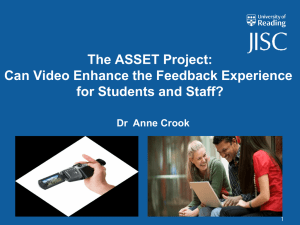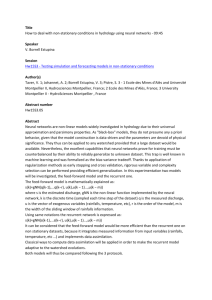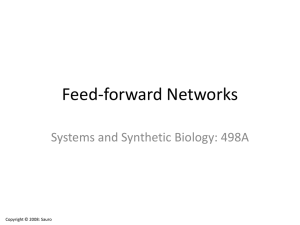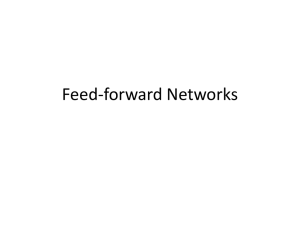Feedback to feed forward. Advocacy Training on vocational courses
advertisement
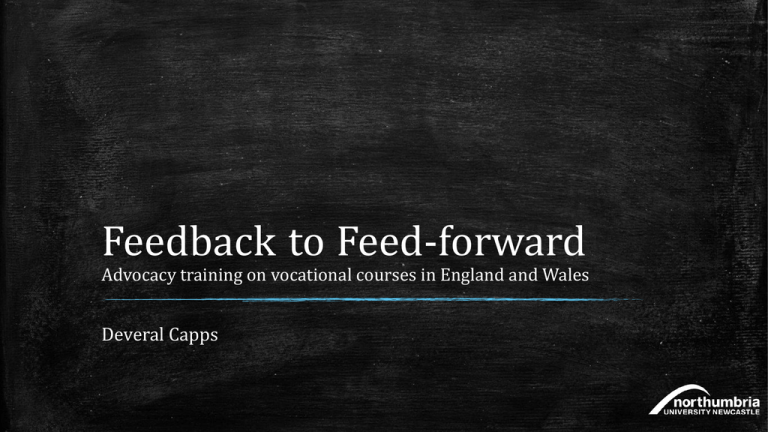
Feedback to Feed-forward Advocacy training on vocational courses in England and Wales Deveral Capps Today’s paper ▪ What does feedback mean? ▪ Outline some of the methods for delivering feedback in advocacy ▪ Look at the aims of feedback ▪ What is meant by the term longitudinal development? ▪ Review some underpinning educational learning theories ▪ Consider tensions and possible solutions! ▪ Comments and questions What is feedback? Feedback is "any information, process or activity which affords or accelerates student learning based on comments relating to either formative assessment or summative assessment activities.” (Irons, A) What is feedback? “Feedback provides information to learners about where they are in relation to their learning goals, enabling them to evaluate their progress, identify gaps or misconceptions in their knowledge and take remedial action. Generated by tutors, peers, mentors, supervisors, a computer, or as a result of self-assessment, feedback is a vital component of effective learning.” (JISC) Types of available feedback in advocacy ▪ Oral feedback ▪ Written feedback ▪ Oral feedback with notes ▪ Recorded performance with oral feedback ▪ Recorded performance with oral and written feedback ▪ Self-reflection / selfassessment ▪ Peer review ▪ Nita ▪ Hampel The Hampel method (ATC) ▪ A Headline is given; ▪ Playback occurs; ▪ A Reason is given; ▪ A Remedy is provided; ▪ A Demonstration is performed; ▪ Replay takes place. What is the aim of feedback? ▪ Correction ▪ Reinforcement ▪ Forensic diagnosis ▪ Benchmarking ▪ Longitudinal development What is feed-forward? Feed-forward looks ahead to the next opportunity to perform and offers constructive guidance on how to improve. Feed-forward Feedback Your structure is poor Feed-forward You need to use a more appropriate structure. Your language is too casual You need to use more and familiar professional language and be deferential to the court Is the feed-forward sufficient? Feedback can only be effective when the learner understands the feedback and is willing and able to act on it” (Price). Is the feed-forward sufficient? Feedback Your structure is poor Feed-forward You need to use a more appropriate structure. Your language is too casual You need to use more and familiar professional language and be deferential to the court Hampel & Feed-forward Feedback Feed-forward Headline & Reason Remedy, Demonstration and Replay Educational theory in advocacy ▪ Learning styles ▪ Kolb’s ‘experiential learning cycle’ ▪ Kapur’s ‘productive failure’ Learning styles There are numerous ways to separate learning styles Honey and Mumford – activist, theorist, pragmatist and reflector Flemming – Visual, Aural/auditory, Read/write, Kinesthetic IF PEOPLE LEARN IN DIFFERENT WAYS SHOULD FEEDBACK IDEALLY BE DELIVERED IN DIFFERENT WAYS TOO? Kolb’s 4-stage experiential learning cycle Kapur’s theory of ‘productive failure’ People learn more deeply and remember things better when they have found the answer to a problem themselves. “floundering is good” Conclusions and positives Feed-forward aka longitudinal development is seen by many as being beneficial for students because they improve rapidly; You can get students to an exit standard fairly swiftly; If feed-forward is explained in language that the student will understand it will have great benefit; Hampel does feed-forward very well indeed with requiring reason, remedy and demonstration; Conclusions and tensions ▪ If we have feed-forward in a skill like advocacy, are we making it too easy for the students? ▪ Feed-forward clearly gives quick and immediate results, but does it stand the test of time? ▪ There is arguably deeper learning if students are given less support (Kapur) and that some degree of floundering is good! Is feed-forward without thought good? ▪ By feeding-forward, are we are encouraging students to miss out arguably the most important 2 stages of Kolb’s learning cycle? QUESTIONS AND COMMENTS
